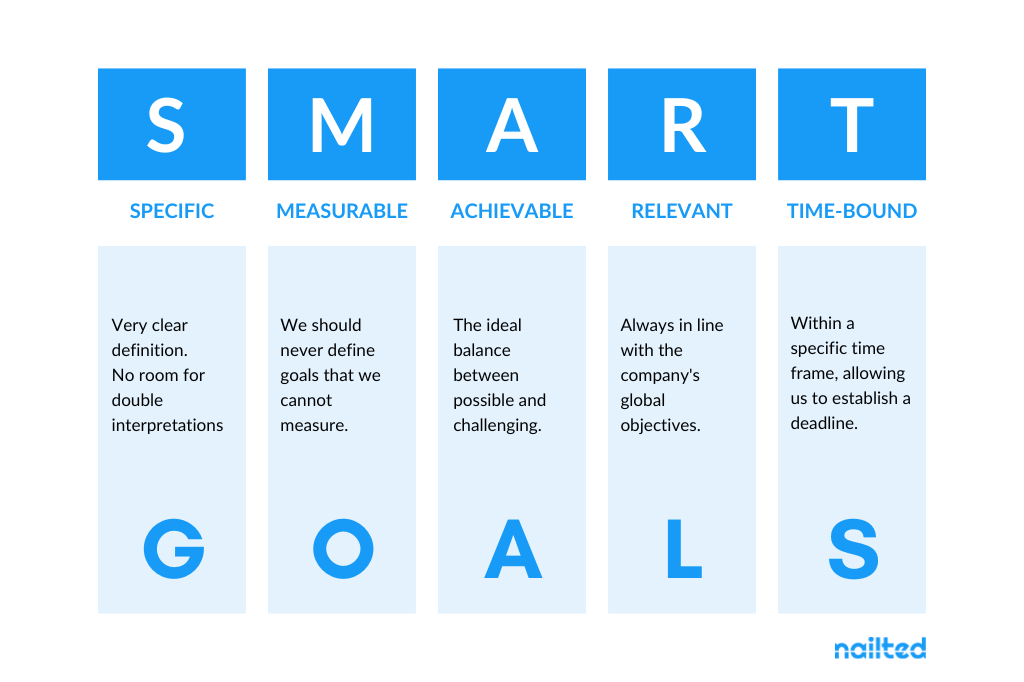Aligning employees based on goals is an essential part of any team’s performance. Setting goals allows us to define a roadmap to success: where we are and where we want to go. In this way, we can evaluate their progress over time, detect trends, strengths, irregularities and opportunities for improvement. But for this to happen, we must ensure that we have defined our goals in the right way. This is what SMART goals are for.
What is a SMART goal?
It is very likely that before arriving here you have already heard about SMART goals, a goal setting methodology that started more than 40 years ago. The SMART goals concept was launched by George T. Doran in the 1980s with the publication of “On the profession of management”. But it was Paul J. Meyer who popularized the term in the business sector with the publication of “Attitude is everything”.
To achieve an ambitious goal, being clear about what we want to achieve is the first step, but without establishing a path to achieve it, it will be very difficult to make it happen. This is where SMART objectives come into play. The term SMART is an acronym which gives us clues about the steps we must follow for the definition of objectives that will guide us on the road to success.
SMART goals refer to goals that should be:
- Specific
- Mesurable
- Achievable
- Relevant
- Time-bound
It is based on these characteristics that SMART goals are written. Take a look at a section below on writing SMART goals to find out how to do it the right way.
What are the benefits of SMART goals?
Nowadays there are few work teams in companies that in one way or another have SMART goals. Implementing the SMART framework in a company helps to:
- Define clear targets that can be understood by all team members.
- These clear targets must be realistic. There is no point in defining overly ambitious goals that are impossible to achieve.
- Focus actions in a specific direction, with a precise approach that avoids distractions or confusion.
- Measure without errors, so that defining success becomes an objective aspect.
- Motivate the team. Any form of measurement motivates the team to make ever-increasing progress in the percentage of achievement of its goals.
- Prioritize based on their current relevance and contribution to the success of the organization.
- Adapt to change. SMART goals allow such a level of granularity in their definition that they are considered 100% adaptable to any situation or change that may arise.
- Provide transparency in organizational terms by defining clear goals for all employees.
- Learning based on progress, mistakes and successes.
- Promote sustainability by defining realistic and achievable goals that encourage vertical growth of the organization.
What does the acronym SMART stands for, with examples
As we have already mentioned, SMART refers to specific, measurable, achievable, relevant and time-bound objectives. But what exactly does each of these indicators refer to?

Specific goals
The SMART goals framework is governed by the definition of very concrete goals, where there is no room for double interpretations. Thus, to ensure compliance, you must confirm that the objective is specific to the job that the designated person is performing.
> Example:
We may want to increase the volume of employee survey participation, and that would be a very valid goal. But without knowing exactly what we want to achieve, how would we know if we have achieved the goal? To define a specific goal we must go into more detail: “increase the volume of participation in employee satisfaction surveys”. Here we know exactly what kind of employee surveys we are referring to, exactly what our goal is.
Measurable goals
This is perhaps the most important indicator to bear in mind. And not only for the SMART methodology; we should never define goals that we cannot measure. Otherwise, how would you evaluate the success or failure of your actions? While evaluating the progress of a goal we must be able to know to what extent the goals are being achieved. That will give us measurable goals.
> Example:
We might want to measure the engagement and satisfaction of our employees, but what would tell us that this goal has been met?
- The definition of the metric to measure: eNPS
- The definition of a target (same concept as discussed in the previous point): +55
- The possibility of measurement: here comes the crux of the matter, do we have a method of collecting information that allows us to measure this data? In this case, it would be enough to have a People analytics tool that provides us with this information, for example.
Achievable goals
By achievable we mean realistic. Is it a goal that is possible to achieve based on our projection and the resources we have? Here we must not only take into account the economic power of the company or team, but also the human hands that will be available to carry out the actions.
By achievable we mean realistic. Is it a goal that is possible to achieve based on our projection and the resources we have? Here we must not only take into account the economic power of the company or team, but also the human hands that will be available to carry out the actions.
> Example:
We could set the goal of having a customized career plan for all 300 employees within two months. But with 2 employees in the people department, it is not feasible to define customized career plans for each employee. In this case, we could define specific career plans by department and seniority, for example, which could help us reduce the work from 300 career plans to 30. This would make it an achievable goal.
Relevant goals
An objective is relevant when it is in line with the company’s future and business objectives. If the objective we are defining goes in the opposite direction, what would be the point of achieving it? To do this, it is important to have a thorough understanding of the company’s situation and the problem we are trying to solve.
> Example:
Let’s take the case of a company that has a turnover rate of 35% and wants to set a goal of reducing it to 15%. You could define an action plan that would be to design ad hoc career plans for employees, but maybe your problem is not in career development, but in workload. In this case, it would be useless to prepare career plans as a means to progress in the objective, because it is something that, presumably, would not impact on your improvement. In this case, it would be more interesting to define actions to reduce this workload.
Time-bound goals
The objectives that we define must be encompassed within a specific time frame, they must be limited to a specific time. This step is delicate since the time defined for the fulfillment of an objective can make it go from being feasible to not being feasible.
> Example:
Let’s go back to the case of defining career plans for the 300 employees. It is not the same to say that we will define 30 career plans in 2 months than in 2 weeks, is it? The possibility of achieving the objective varies enormously. Here we must assess in what time frame it is feasible to achieve those results and adjust the rest of the parameters so that they can remain Achievable and Relevant, regardless of the time period in which the objectives are achieved.
Now that we are clear on how each of the indicators that make up the SMART methodology works, let’s look at how to write SMART goals to make them truly effective.
How to write SMART goals in 5 steps
As we have just seen, SMART indicators give us the keys to define goals efficiently. Now we just need to know how to interpret them correctly and align them with our needs.
Follow the steps below and in no time you will have SMART goals ready to evaluate the success of your objectives.
1. Analyze the current situation
The first step, before getting down to defining the goals, is to analyze the current situation. To do this, use the following questions:
- What improvements have we detected in the department?
- How many people are in the team?
- How many goals can each person in the team assume? At Nailted we recommend a maximum of 4 or 5. Always taking into account the scope of each problem and whether it will be possible to focus exclusively on them. If this is not the case, it should be reduced to a maximum of 2.
- Which issues have the highest and lowest priority? It is time to make a list to see which issues are unavoidable and which ones can be dealt with in a second phase.
2. Define a specific goal
Once we have our prioritized list of issues to address, the next step is to address the first SMART indicator: Specific. How do we define specific goals? You probably already have an idea of a goals in mind, ask yourself the following questions:
- What does the goal seek to achieve?
- Does the goals have double interpretations? If the answer is yes, we should adjust the definition of the goal.
- Is the “what for” of the goal clear? If the answer is no, the goal is not specific enough.
- Is the goal relevant to the person or area responsible for it? If the answer is no, we should check whether the problem is in the definition of the goal or in the assignment of the responsible person.
3. Ensure that the goal can be monitored
The third step in writing SMART goals addresses the second SMART indicator: Measurable. Have we defined a measurable goal? We continue to ask ourselves questions to ensure that our goal is valid:
- Are there any measurable metrics behind our goal? If the answer is no, we will need to revisit the goal and find a way that it can be aligned with a metric that will help in its measurement.
- Have we defined a target to be achieved? We need to define a numerical target, something that defines where the goal is that we need to get to.
- Do we have a method of collecting information that will allow us to measure this data? If not, we have two options: we can re-evaluate the goal to define one from which we can extract data. Or we can review what methods or tools will allow us to get the information we need.
4. Ensure that the goal is achievable, relevant and time-bound
The fourth step in writing SMART goals encompasses the last three SMART indicators: Achievable, Relevant and Time-bound. We continue with the questions to confirm that our goal is successful:
- Is the goal set in line with the organizational objectives? If the answer is no, we must stop to align the teams to ensure that everyone is rowing in the same direction.
- Is it possible to achieve the goal set based on the resources we have? If the answer is no, we must stop to define a more realistic framework for the definition of our goal.
- Have we defined the time frame in which we must achieve the goal? If not, we must do so. Without a time frame that encompasses our goal, we cannot consider it a SMART goal.
- Is it possible to achieve the goal we have set based on our projection? We must review the evolution history and ask ourselves if it is really an achievable goal based on the context in which we find ourselves.
- Is our goal challenging? It is important to define viable and achievable goals, but if they remain in the same line as in previous periods, it is not challenging. To give you an idea, meeting a target at 80% is considered successful, and based on that history, define a one-point increase over the progress achieved in the previous period.
5. Choose a goal management methodology
Without a common goal management methodology, there will be no alignment between the different teams. In short, each one will most likely be rowing in a different direction. To avoid this, there are goal management methodologies such as the OKR methodology.
The OKR methodology provides the visibility needed for employees to understand how their goals connect with those of their peers to achieve overall success. In other words, it is the way to measure organizational objectives based on individual measurable factors that reflect the benefits of teamwork.
The OKR methodology allows you to organize goals in such a way that the connection between organizational, or parent, objectives and individual, or child, goals, as well as the people involved in them, is clear. This makes it easier to align employees around the organization’s objectives.
SMART goals examples: let’s define goals together
Following the steps discussed in the previous section, we are going to define a series of SMART goals for a People department. To do this, we answer the questions described above and define what our SMART goals will be.
1. We analyze the current context in which we find ourselves
First, we analyze the situation in which we find ourselves:
- What improvements have we detected in the department?
- High employee turnover
- Low participation in surveys
- Deficiencies in communication
- Leadership problems
- New employee attrition during the onboarding process
- Demand for professional development plans for employees
- Low employee engagement rate
- How many people are on the team? 2
- How many objectives can each person in the team take on? Taking into account the scope of the issues, at most each person can take on 2 objectives, a total of 4.
- Which issues are more and which are less of a priority?
- High employee turnover
- Low employee engagement
- Leadership issues
- Low participation in surveys
2. We define goals based on the problems detected
Next, it is time to define our goals based on the problems we have detected:
- What are we looking to achieve?
- High employee turnover > Reduce employee turnover rate.
- Low employee engagement > Increase eNPS in the team.
- Leadership problems > Increase the use of 1:1 meetings between managers and employees.
- Low survey participation > Increase employee survey participation rate.
- Does the objective have dual interpretations? The only objective that could have a double interpretation is the last one, since we have not specified which surveys are involved and it could range from feedback surveys on the UX of the website to surveys on the quality of the relationship with customers.
- Increase the rate of employee participation in satisfaction surveys.
- Is the “what for” of the objective clear? Yes, all objectives have a clear focus for improvement.
- Is the objective relevant to the person or area responsible for it? Yes, they are all related to the employee experience and therefore the responsibility lies with the People team.
3. We make sure that goals are measurable
As a third step, we need to make sure we have a way to measure the goals we have set for ourselves:
- Are there any measurable metrics behind our goal?
- Reduce employee turnover rate: turnover rate.
- Increase eNPS in the team: eNPS
- Increase the use of 1:1 meetings between manager and employees: 1:1 meetings conducted.
- Increase employee participation rate in satisfaction surveys: percentage of participation in surveys.
- Have we defined a goal to achieve?
- Reduce employee turnover rate to 15%.
- Increase eNPS in the team by +55.
- Get 75% of employees to have at least one meeting per month with their manager.
- Increase employee participation rate in satisfaction surveys by 80%.
- Do we have a method of collecting information that allows us to measure this data? For all objectives we have an employee engagement platform that helps us to measure all these data.
4. We define the time frame
We must now define a time frame for our goals and ensure that they are achievable and relevant:
- Is the goal set in line with organizational objectives? Yes, for this year an organizational objective has been defined for the improvement of the employee experience.
- Is the target set achievable based on the resources available to us? Yes, we have already measured the size of the objectives and assigned 2 to each team member.
- Have we defined the time frame in which we must achieve the objective? All objectives will be reviewed quarterly. Therefore, at the end of Q1, we will evaluate the progress of the objectives for subsequent iterations for Q2.
- Is the target set achievable based on our projection?
- Reduce employee turnover rate to 15%: our current rate is 25%, considering that no work has been done on employee experience in the past, a 10% reduction could be feasible.
- Increase the eNPS in the team by +55: we are currently at +35, taking into account what was mentioned in the previous point, we also consider it feasible.
- Achieve that 75% of employees have at least one meeting per month with their manager: today no one is doing it because we do not have a tool for it, therefore, we will set a lower adaptation target, 50%.
- Increase the rate of employee participation in satisfaction surveys by 80%: every month we increase participation by 5%, considering that we are now at 60%, we see it as viable.
- Is our target challenging? Yes, based on historical data, we have defined an increase of a few points over the progress achieved in the previous period.
And we would already have our SMART goals!
- Reduce employee turnover rate to 15% during the first quarter of the year.
- Increase eNPS in the team by +55 during the first quarter of the year.
- Achieve 50% of employees having at least one meeting per month with their manager during the first quarter of the year.
- Increase employee participation rate in satisfaction surveys by 80% during the first quarter of the year.
As we can see, they all follow the same structure:
- They are Specific because the goal to be followed is clearly defined.
- Measurable because they all have a metric to measure and a goal to achieve.
- They are Achievable based on the history of the previous quarter.
- They are Relevant because they are aligned with an organizational objective.
- They are Time-bound because the date for their fulfillment should be at the end of the quarter.
SMART goals template
To standardize the SMART methodology in your company you need a framework to which all employees have access. Having this framework in place will allow employees to define SMART goals independently.
What is a SMART methodology template?
The SMART methodology template is a reusable guide for the correct implementation of SMART goals in your company. This template allows your team to define specific, measurable, achievable, relevant and time-bound goals in order to be able to follow them up properly. Having a common template for all employees will allow the whole company to be aware of the standard for goal setting, which will improve alignment among employees.
Your template for SMART methodology
Ideally, you should create your SMART template once, so that it can be used for subsequent iterations. Keep in mind that SMART goals are typically updated quarter by quarter. Thus, from one quarter to the next, your goals template should allow you to clone those set in the previous quarter and include those updates in the values that the team considers relevant for the new quarter.
In order to help you compose this guide for the definition of SMART goals, we have adapted the questions for each of the SMART indicators. In this way, those who are not so familiar with the SMART methodology will be able to get used to it and define their objectives efficiently:
Your goal must be specific:
- What are you seeking to achieve?
- Does your goal have double interpretations?
- Is it clear what impact your goal will have on the organization?
- Does the goal have a close relationship to your work?
Your goal must be measurable:
- What metrics will you use to measure your goal?
- What goal do you want to achieve?
- Do you have the necessary tools to collect that information?
Your goal must be achievable:
- Do you think you can achieve your goal with the resources you have?
- Based on history, do you think it is possible to achieve the goal?
Your goal must be relevant:
- Is your goal aligned with organizational objectives?
- Is it challenging for you?
Your goal should be time-bound:
- Have you defined a deadline for the achievement of your objectives?
Now that you have your goal defined, write it down on a piece of paper and note and justify where and/or how you envision the following parameters:
- The specificity of the objective: what you seek to improve.
- Its measurability: the metric that will guide its evolution.
- Its achievability: the history that shows that the defined goal is feasible to achieve.
- Its relevance: note the organizational objective on which it impacts.
- The deadline for compliance.
The definition and management of SMART goals plays a key role in any company’s path to success. The SMART methodology allows employees, managers and People teams to promote team alignment, professional development and the correct follow-up of organizational objectives.
If you are a demanding HR professional and want to implement goal management in your company in a solid way, you can manage your goals with Nailted. We help you create your goals template, putting all the necessary technology behind it so you don’t have to worry about anything else. In addition, you will have access to an administrator dashboard from which you can have full control over the use and progress of all the goals.
Remember that by defining SMART goals in your company you will be guiding the team’s work towards the achievement of goals and promoting a culture of accountability where all employees feel responsible and participate in the company’s success.








